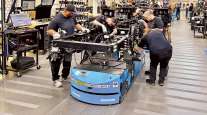In May, US Employers Added Fewest Workers in Almost Six Years
The addition of 38,000 workers, the fewest since September 2010, followed a 123,000 advance in April that was smaller than previously estimated, a Labor Department report showed June 3. The increase in May was less than the most pessimistic forecast in a Bloomberg survey. The jobless rate dropped to 4.7%, the lowest since November 2007, as Americans left the labor force.
The for-hire trucking industry reduced payrolls by 2,400 in May, and for the year, trucking payrolls are off by 3,400. In 2015, the industry added a total of 20,900 jobs.
Smaller employment gains reduce the odds of a more pronounced upturn in household spending and economic growth after a poor start to the year. Fed officials will take into account more judicious hiring, at a time when corporate profits are on a downswing and global markets remain weak, as they consider whether to raise interest rates again.
“It will put a dent in optimism about the second-quarter rebound,” Thomas Costerg, senior economist at Standard Chartered Bank in New York, said before the report. “A lot of hopes are hanging on the labor market. If job growth softens it’ll be a signal that the U.S. economy is a bit more fragile than we think. There are a lot of question marks about the second half.”
The median forecast in a Bloomberg survey of economists called for a 160,000 gain in May employment. Estimates of 90 economists ranged from job gains of 90,000 to 215,000 after an initially reported 160,000 increase in April. Revisions to prior reports subtracted a total of 59,000 jobs from payrolls in the previous two months.
The report showed a broad hiring slowdown, including declines in payrolls in construction, manufacturing and mining. Job growth at private service producers slowed, with employment climbing by just 61,000. That brought the diffusion index, which measures the breadth of hiring, to 51.3 in May, the lowest since February 2010.
Furthermore, Americans who are working part-time and would rather have a full-time position, or the measure known as part-time for economic reasons, climbed to 6.4 million in May, the highest since August, from 6 million a month earlier.
The unemployment rate, which is derived from a separate Labor Department survey of households, was projected to drop to 4.9%, matching the lowest level since 2008, from 5%, according to the survey median.
A bright spot in the report was worker pay. Average hourly earnings rose by 0.2% in May after a 0.4% gain in April that was a bit stronger than initially reported. Worker pay increased 2.5% over the 12 months ended in May.
The report showed weakness in sectors vulnerable to slow overseas markets and the cutbacks in energy investment, along with hiring slowdowns in services.
Factories cut employment for the third time in the last four months, while construction companies shed 15,000 jobs.
The payrolls figure also reflected a work stoppage at Verizon Communications Inc. that Labor Department data showed involved some 35,100 workers, the most in four years. Those workers were idle for the entire payroll survey pay period, which includes the 12th of the month.
Landline workers at Verizon began protesting in April as the company sought to increase workers’ contributions for health benefits and greater flexibility in temporary job relocations.
The June 3 report showed employment in the information sector dropped by 34,000.
Fed policymakers, who are considering when to next raise interest rates after lifting them in December for the first time in almost a decade, have said they expect continued improvement in the job market.




